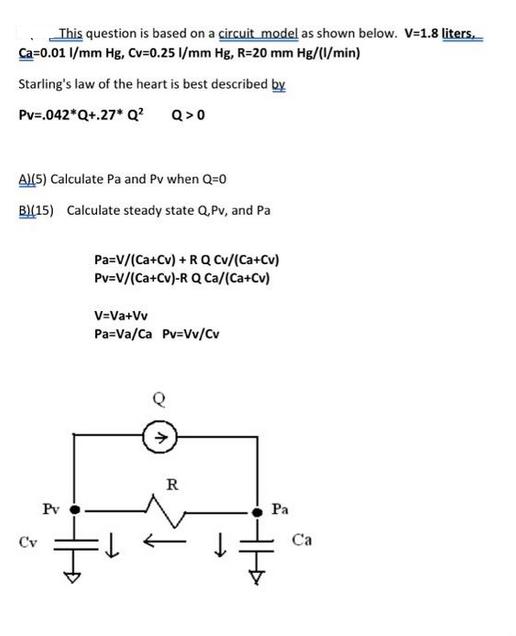Question
This question is based on a circuit model as shown below. V=1.8 liters. Ca=0.01 1/mm Hg, Cv-0.25 1/mm Hg, R=20 mm Hg/(l/min) Starling's law

This question is based on a circuit model as shown below. V=1.8 liters. Ca=0.01 1/mm Hg, Cv-0.25 1/mm Hg, R=20 mm Hg/(l/min) Starling's law of the heart is best described by Pv=.042*Q+.27* Q Q>0 A)(5) Calculate Pa and Pv when Q=0 B)(15) Calculate steady state Q,Pv, and Pa Pa=V/(Ca+Cv) + R Q Cv/(Ca+Cv) Pv=V/(Ca+Cv)-R Q Ca/(Ca+Cv) Cv V=Va+Vv Pa=Va/Ca Pv=Vv/Cv Py # R Pa Ca
Step by Step Solution
There are 3 Steps involved in it
Step: 1

Get Instant Access to Expert-Tailored Solutions
See step-by-step solutions with expert insights and AI powered tools for academic success
Step: 2

Step: 3

Ace Your Homework with AI
Get the answers you need in no time with our AI-driven, step-by-step assistance
Get StartedRecommended Textbook for
Smith and Roberson Business Law
Authors: Richard A. Mann, Barry S. Roberts
15th Edition
1285141903, 1285141903, 9781285141909, 978-0538473637
Students also viewed these Programming questions
Question
Answered: 1 week ago
Question
Answered: 1 week ago
Question
Answered: 1 week ago
Question
Answered: 1 week ago
Question
Answered: 1 week ago
Question
Answered: 1 week ago
Question
Answered: 1 week ago
Question
Answered: 1 week ago
Question
Answered: 1 week ago
Question
Answered: 1 week ago
Question
Answered: 1 week ago
Question
Answered: 1 week ago
Question
Answered: 1 week ago
Question
Answered: 1 week ago
Question
Answered: 1 week ago
Question
Answered: 1 week ago
Question
Answered: 1 week ago
Question
Answered: 1 week ago
Question
Answered: 1 week ago
Question
Answered: 1 week ago
Question
Answered: 1 week ago
View Answer in SolutionInn App



